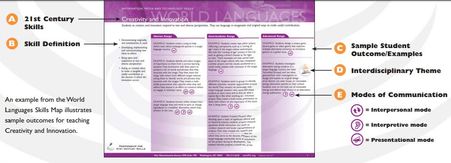
Every teacher’s lesson plans should reflect 21st Century World Languages Curriculum. What is 21st Century World Curriculum? According to ACTFL’s 21st Century Skills Map, in order for students to become college and career ready, they need to be proficient in other languages, regardless of whether they enroll into a college or go straight into the workforce. Language and communication are at the heart of the human experience, which is why 21st Century Skills in learning a new language, are centered around five goals known as the 5 Cs. The 5 Cs consist of, communication, cultures, connections, comparisons, and communities. Today, learning a new language in school is extremely different to how it was over two decades ago. Back then students learned about the language, but never really had the chance to put it into practice outside of the classroom. Mostly because it was not an expectation teachers had of their students. In today’s language learning classroom, however, a teacher’s goal is to have students learn a new language so that they can ultimately communicate in the target language with native speakers of the language.
In today’s language learning classroom, teachers do not want students to simply learn about the language, such as grammar, but instead to actually be able to use it on their own and outside of the classroom. Grammar is important, however, it should not be the main focus. We want our students to learn a new language in a similar way to how they learned their native language…by hearing people use it, model it, and then be able to start communicating on their own in it.
The way that I structure my lesson plans, is to first start with the learning goal(s) of the unit, and what I want my students to be able to do by the end of the unit. Then I create a roadmap full of pit-stops (smaller goals) that will ultimately lead to the ending goal. This way of lesson/unit planning is called “Backwards Design”; it’s designing with the end in mind.
An example of a lesson assignment I created for my Spanish 1 students is below. The purpose of this assignment is to get students to use the Spanish they have been learning (put it into practice and make it meaningful), and for me to be able to browse the room and assess students comprehension. The goal is for students to communicate with their classmates in ONLY Spanish by asking each other questions that are on the worksheet I gave them. It is one thing for students to be assessed by their teacher, but it is always great to have students assess themselves. That is why at the bottom of the worksheet there is a section where students are asked to assess themselves on how they completed the activity. It is always helpful to the teacher to know where their students “think or feel” they are academically in the class.
In today’s language learning classroom, teachers do not want students to simply learn about the language, such as grammar, but instead to actually be able to use it on their own and outside of the classroom. Grammar is important, however, it should not be the main focus. We want our students to learn a new language in a similar way to how they learned their native language…by hearing people use it, model it, and then be able to start communicating on their own in it.
The way that I structure my lesson plans, is to first start with the learning goal(s) of the unit, and what I want my students to be able to do by the end of the unit. Then I create a roadmap full of pit-stops (smaller goals) that will ultimately lead to the ending goal. This way of lesson/unit planning is called “Backwards Design”; it’s designing with the end in mind.
An example of a lesson assignment I created for my Spanish 1 students is below. The purpose of this assignment is to get students to use the Spanish they have been learning (put it into practice and make it meaningful), and for me to be able to browse the room and assess students comprehension. The goal is for students to communicate with their classmates in ONLY Spanish by asking each other questions that are on the worksheet I gave them. It is one thing for students to be assessed by their teacher, but it is always great to have students assess themselves. That is why at the bottom of the worksheet there is a section where students are asked to assess themselves on how they completed the activity. It is always helpful to the teacher to know where their students “think or feel” they are academically in the class.
| interpersonal task- preguntas para tus compañeros |
